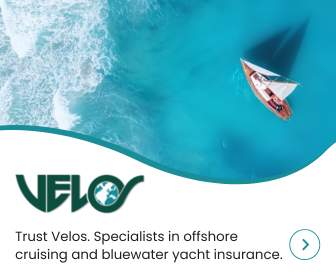Indonesia: Cruiser Paradise or Paradise Lost?
Indonesia is one of the most diverse cruising grounds in the world, from the surf-rich islands off the West Coast of Sumatra to the pristine waters of the Raja Ampat Archipelago in the east, over 2000NM away. With such a widespread country there also comes challenges for the cruising sailor, in particular formalities, regulations and requirements, the application of which varies at ports of entry throughout the country. Cruising Indonesia right now seems to be an ever-changing set of rules and involves a great deal of paperwork, bureaucracy, patience and money. In this report we outline the current situation, what you can expect and offer suggestions as to how to avoid some of the pitfalls.
Published 3 years ago
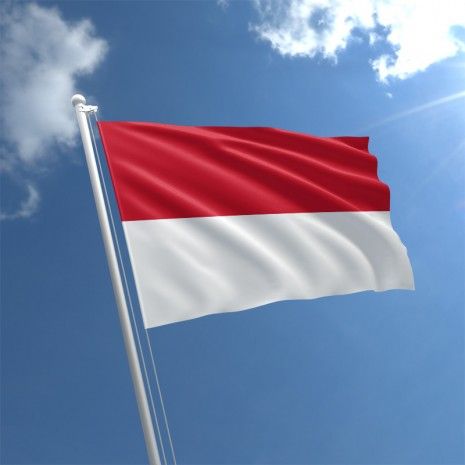

Currently there are 28 official ports of entry for yachts and 23 official seaports where Visas on Arrival (VOAs) can be obtained. Across the archipeleago, cruisers are reporting different experiences and varying interpretations of the rules by officials at ports of entry.
Some cruisers using agents for clearing in have reported being faced with very expensive (agent) fees, hidden costs and charges being applied at either check-in or check-out which they had not previously been aware of. Others have found regulations are applied differently from port to port and in one case a cruising boat was prohibited from leaving the country because of incomplete or inconsistent document requirements that they had been completely unaware of during their time in Indonesia.
On the other hand, there are cruisers that have reported being able to check-in without having to use an agent, friendly and welcoming officials and fees that were in line with what was expected.
Yachters ID System
The Yachters I.D system was introduced in February 2016 to try and make clearance and cruising through Indonesia simpler with pre-arrival paperwork all online. However, since COVID and borders re-opening it seems that many ports are re-implementing old systems and now, just to top it all, using an agent has become mandatory, further increasing clearance costs.
Therefore, as well as doing all the pre-arrival online paperwork, cruisers need to be prepared to do more paperwork once they arrive or when they depart, which could involve paying out a great deal of money.
In addition, there is confusion about the “Sailing Permit” that requires Harbour Master Clearance from the first port of entry, to be able to cruise through Indonesia, as well as harbour master clearance from any port that you visit along the way.
In this report we endeavour to outline current requirements based on information provided by recent cruiser experiences and from contacts on the ground in Indonesia. It is always prudent, however, to double check requirements and paperwork with an agent or local officials prior to arrival, as the situation is in a state of flux.

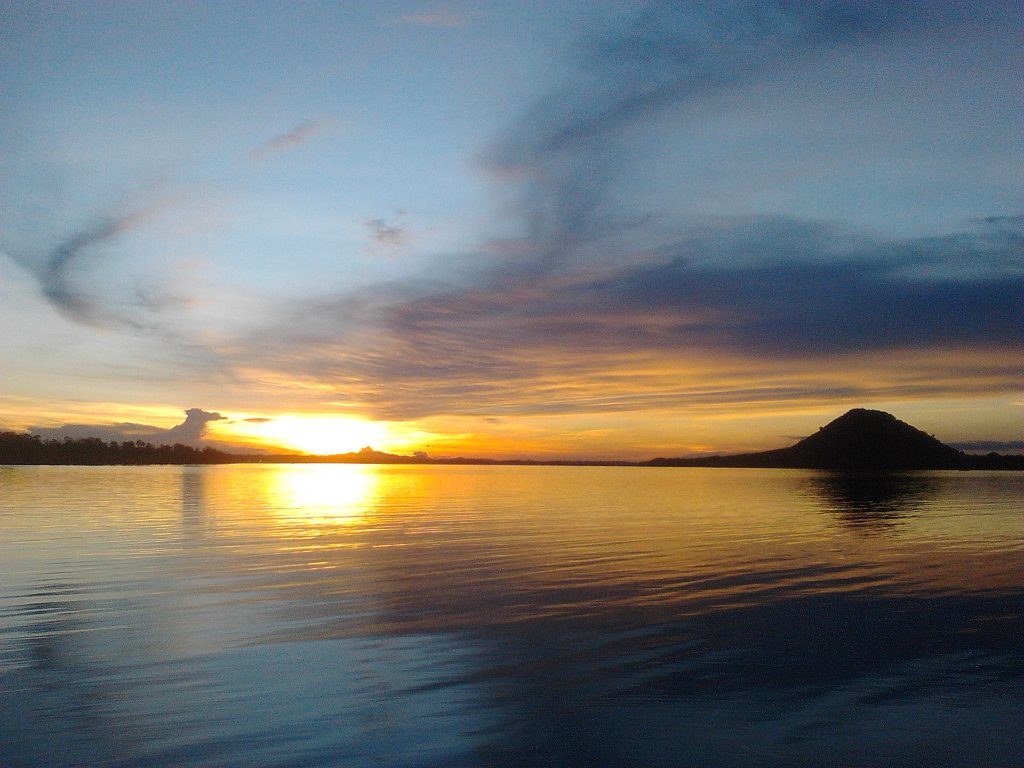
- Sunset over the Riau Islands, provided by Sue Woods
Ports of Entry/Visas on Arrival
There are currently 28 official Ports of Entry for yachts wanting to enter Indonesia. From reports to Noonsite, cruisers have been able to check in, without any issues and in some instances without any agents, at Benoa, Bali; Biak, West Papua; Tanjung Pandang, Belitung.
Checking out of your first port of entry – the “Sailing Permit”
Before leaving your first Port of Entry, it is very important to get a “Sailing Permit” (Port Clearance) from the Harbor Master. This is the document that allows you to sail to all other Indonesian ports and will be needed when checking out of the country.
This clearance paper should be from the Port of Entry to your last port where you will leave Indonesian waters. However, some cruisers have reported that this document has to be presented to the Harbour Master in every harbour you visit and will be stamped there.
Warwick Elliston who runs the Helena Marina and Tampa Garam Boat Harbour in Sorong, explains why. “I think where the confusion arises is that the local harbour authorities actually have an obligation to know what ships/vessels are moving in their area of control”, he said. “In Sorong Harbour for instance, it is a simple matter of advising of arrival or departure. Of course for vessels leaving the country it is vital for them to have a “clearance out” of the country along with the other formalities with regard to Quarantine, Immigration and Customs.”
A yacht that attempted to check out of Indonesia at Nongsa Point Marina without said “Sailing Permit” – after checking into Indonesia in Tual – found to their dismay that they did not have the correct documents and were threatened with five years imprisonment or a fine of 600 Million Rupiah (40,000 Euros) for being a commercial ship (because they did not have the correct paperwork for a cruising yacht).
The yacht skipper, Fritz, told Noonsite that unfortunately the situation occurred because their agent, when they checked into Indonesia in Tual, did not do his job and provide them with the correct documentation. Fritz also said, “When you pay an agency and they are not doing their job, what you can do as customer who knows nearly nothing? On the positive side, we got another agent who was able to do our visa extensions online directly with Immigration in Jakarta, so we are not going to overstay and face a fine of 1 million rupiah/65 Euros per day as overstayers!”
Aim to get more paperwork than you think you need
The official vessel declaration system of the Indonesian government provides a document (in English) called “Recommendations for Foreign Yachters”. In this document it states: “Once this procedure (clearance) is complete your yacht is free to move about Indonesia without reporting to another harbor master until you are ready to exit from Indonesia permanently.”
These recommendations, however, are incomplete as there is no mention of the required “Sailing Permit”. Fritz told Noonsite they did receive the official document, but it is in Indonesian so they were unable to confirm the details. Nongsa Point Marina Manager, who was trying to assist them with their difficulties, told them “these are the actual working rules for visiting yachts.”
Therefore, if you put your faith in the Government vessel declaration system, it will be possible that your paperwork will be incomplete and you may have difficulties departing the country, face a fine or even be threatened with imprisonment like Fritz.
Moving around Indonesia
Kristin Cowan, who recently checked into Indonesia in Bali after sailing from Dampier in Western Australia, found that they had to have Harbour Master clearance just to move from Benoa to nearby Serangan.
“We found that going to Benoa first to check in and then moving to Serangan the next morning worked very well for us,” she said. “However, before leaving Benoa, even for nearby Serangan, it’s very important to get a “Sailing Permit” (Port Clearance) from the Harbour Master. This is the document that allows you to sail to all other Indonesian ports and will be needed at check out of the country. We gave them our signed crew list and the document cost about $1.” Read Kristin’s report here.

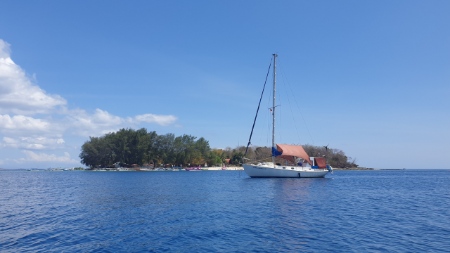
- At anchor in Indonesia.
Noonsite contacted Raymond Lesmana, who has been advocating for easier processes for sailors for many years, to get some clarification. He confirmed that Officials have the right to ask to see your Clearance Sailing Permit and Visas, but that is all.
“The Sailing Permit is from your Entry Point in Indonesia and should be addressed to the Last Port where you will exit Indonesia. There is no requirement for Domestic Clearance based on Presidential Decree No 105/2015.”
Legislation for using an Agent
A regulation that requires all vessels, such as recreational yachts, to use a shipping agent for clearance processes into and out of Indonesia, is now being enforced according to information received from tourism officials.
Raymond Lesmana, said that the “new” regulations have in actual fact been around for years, but not for Non-Commercial Vessels/Yachts.
“The regulations are now being enforced for yachts,” he said. “This means that the entry costs for visiting yachts will now be more expensive, but I just don’t know how this is going to affect yachts coming to Indonesia at the moment.”
Ayu Saraswati who works with Warwick Elliston in Sorong, West Papua, also confirmed that the regulations were not new. “If you read the old regulation (PM 171 Tahun 2015) the content of regulations is the same, but they put additional information for the ship guarantor,” Ayu said. “According to that regulation, a ship guarantor can be a ship agent, ship operator and skipper/captain, so the captain can directly be a ship guarantor for their own yacht if they don’t want to use an agent (even though all check in will be easier if you use an agent).”


- Raja Ampat Islands
So do I need an Agent?
While most current advice is to use an agent who will (should) deal with all clearance formalities and paperwork on your behalf, charges vary widely and it is possible to do it yourself according to several recent reports:
- Benoa, Bali:
Kristin Cowan reported to Noonsite that they checked into Indonesia at Benoa, Bali, without using an agent and while the process was time consuming, it was not difficult.
“At the time of writing (July 2022) you are required to tender both Quarantine officials and Customs officials aboard your vessel so anchoring close to Bali Marina was convenient. The Harbour Master, Quarantine, Immigration and Customs are very close to each other and all within a 10 minute walk from the Bali Marina in the port precinct. The process took about four hours in total of walking, waiting and tendering, but was a pleasant experience with helpful staff in all locations.”

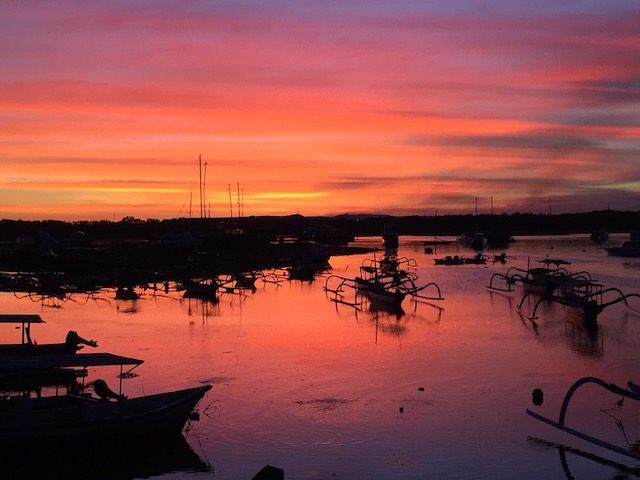
- Sunset over Serangan on the east coast of Bali.
Expensive fees
Kristin’s report contrasts with that of another vessel that checked into Bali earlier in the year and used an agent, which turned out to be a very expensive experience.
After three weeks in Bali, US sailor Erik Sponberg departed for Lombok and reported that “In order to leave, our agent told us we have to “check out” of Bali – which at the same time gives us our clearance paper to visit other ports in Indonesia and specifically names our final check out port, Padang in Sumatra.
“This piece of paper cost us RP1,300,000 (US$93.00). So, add this to the US$1,408 we paid for visas and clearances (US$1,501) and this turns out to be by far the most expensive country (out of 22) that we have visited on our circumnavigation from the US.
“The second most expensive country was Australia which cost us AU$580 for biosecurity inspection (US$435). Then our Australian visas to enter were AU$141.40 each = AU$280.80 = US$211. So, the total cost to enter Australia = US$646. Indonesia entry fees are nearly 2½ times what we paid in Australia.”
Different stories from different ports
Erik explains; “Our story may be unique in costs simply because this is Bali where things appear to be different than the rest of the country. Other cruisers on the various cruising groups on Facebook are reporting wildly different fees with stories that change from port to port. We see no uniformity in the charges, either from internet government sites or from agents. Each agent seems to charge different fees to whatever the market will bear, and they do not delineate what their fees are separate from the costs of the official paperwork from Customs, Immigration, and Biosecurity.
“In most islands there is one agent, if any at all, and you do not seem to save money by going through an agent. I will say our agent did a lot of work for her money as she was very responsive to our inquiries and very expeditious in getting us cleared – we didn’t have to deal with clearing ourselves in and out. It would be a nightmare trying to get to the various offices in a city with crowded streets and no English language street signs and directions. So, our clearing process was easy, just very expensive.”
- Biak, West Papua:
Massimo Vecchietti from SV Patchouli II told Noonsite that he, along with three other boats, were able to check into Indonesia at Biak in West Papua, but the process took four days.
“Our agent was Raimond Lesmana who had provided us with the necessary documents, but we had great difficulty in completing the clearance procedures and it eventually took us four days,” he said.
“It is essential to have a local agent, to extricate yourself from the Indonesian bureaucracy and it is not enough to have one, even if efficient, far away,” he said.
- Tanjung Pandan, Belitung:
Sailors Riley and Klara on Blackduck at Sea, reported that they checked out of Indonesia at Tanjung Pandang in what was a fairly easy process which took about 5-6 hours, including a lunch break and driving between the various offices. The steps they followed can be found here. “It is best to have hardcopies of everything, but if you should happen to be missing something, it is possible to send it in an email and officials will print it for you. I imagine this process would be at least similar in other Ports of Indonesia. It requires no Agent and cost only USD $4.70 and whatever fee you will be able to negotiate for transportation,” they report.
- Bintan/Batam (Nongsa Point Marina)
Luc Callebaut on SV Slopemouche reported to Noonsite that he was not able to check in at Bintan because he had dogs on board, but was instead sent to Batam – Nongsa Point Marina. Dogs are not allowed on Bintan at all. He was also denied entry at Bintan because of incorrect paperwork and not giving enough notice to CIQP (which he said the agent was required to do on his behalf).
“Clearance at Batam was easier but did take several days,” Luc said. “Officials had to come on board to inspect the boat and personnel were pleasant and helpful. However, if you are clearing into or out of Indonesia here, you will be required to use the marina agent for clearances. During our stay there, we met three different foreign boats who had been stuck for days or weeks trying to check out from Indonesia without success, because they did not have their domestic exit permit from the last Indonesian port.”
Tourist Fees and Charges
Indonesia has postponed a sharply higher admission fee for the world-famous Komodo National Park through the end of the year, a tourism ministry official revealed Tuesday, after drawing strong opposition from locals reliant on tourism.
The fee hike is intended to help preserve the habitat of the world’s largest lizards, Komodo dragons, now classified as an endangered species, by curbing the number of visitors.
As of August 1st this year, the entry fee was raised to a flat 3.75 million rupiah ($252) to visit the park’s main islands of Komodo and Padar (25 times the previous 150,000 rupiah for international sightseers on weekdays). Fearing that the hefty price would drive visitors away, local tourism workers called a strike.

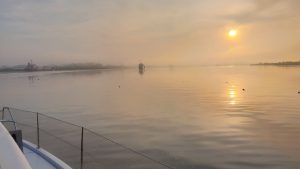
- Entering the Kapuas River on the way to Pontianak, West Kalimantan. Photo (c) Stefan from SV Rainbow Safari
Jakarta announced in June an intended dramatic rise in the admission fee to the Borobudur Temple, a World Heritage Site. The proposal was dropped after an outcry from the tourism industry.
Warwick Elliston said that new charges were also creeping in for other areas of interest like the Raja Ampat archipelago in his area. “The requirement to clear in and out of the local harbors seems to be being used as the collection point for some of the charges,” he said.
Formalities Round-Up
Clearing In
Kristin Cowan said they had copies of all the following documents and needed all of them at different stages in the check-in process, but weren’t asked for anything additional.
- VDS – first few pages of the declaration which includes the official number
- MMSI – email sent when it was issued
- Crew lists – including a place for the Harbour Master, Captain, Quarantine, Immigration and Customs to all sign, date and stamp
- Boat registration certificate
- Covid proof of vaccination/exemption digital certificates
- Passports
- Zarpe from last country visited
Kristin adds; “We were also issued with a Green Book when we checked in to Indonesia in Bali, which officials insisted was still needed in Indonesia, along with a Sanitation Certificate, a Medical Certificate for our First Aid Kit and a Certificate of Pratique.”
Clearing Out
Blackduck at Sea, who cleared out (without an agent) from Tanjung Pandan, Belitung, provided the following documents to officials:
- Boat Registration
- Passports
- Crew List
- Port Clearance into Indonesia
- Vessel Declaration
- AIS MMSI Number
- Visa Documents
- Green Book
- COVID Vaccination Certificates
- Medical Certificate
- Ships Sanitation Certificate
Health, COVID 19 and the Green Book
The Green Book is (again) a requirement along with a Ships Sanitation Certificate and a Medicine Certificate for any First Aid Kit held on board.
Cruiser Fritz confirmed that these documents are obligatory and if you do not have them you may get into difficulties when you try to leave the country, as he did, because he did not get the documents when clearing in to Indonesia in Tual.
- Health book/Green book – should be given at the entry port from Quarantine
- Ships Sanitation Certificate document is valid for 6 months and can be renewed in the closest Quarantine office
- SCMC is the Ship Chest Medicine Certificate, this is for the First aid kit/s and medicine on the boat. This should be given at the entry port from Quarantine. This document is valid for 6 months and can be renewed in the closest Quarantine office
Visas
On Arrival (VOA)
The Visa on Arrival costs Rp. 500.000 and is valid for 30 days. The Visa on Arrival can get extended once, with 30 days, at a local Immigration Office in Indonesia with an extension fee of Rp. 500.000. The Visa on Arrival cannot be converted into another type of stay permit. See the Indonesian Government immigration website for ports where VOAs are available.
Extensions
It is possible for visa extensions to be done online for some visas (onshore visa) and the visa extension is sent by e-mail. It appears easier to use an agent to do this according to cruiser experiences within Indonesia. As soon as the visa extension enquiry is registered in the system you are safe concerning overstay (charged at 1 million Rupiah per day – 65 Euro approx). Latest reports indicate that some immigration offices require the original sponsor letters and biometrics for B211A
visa extensions. You may also be asked for proof of stay (in a marina)
and a Crew List. Cost is approximately 2 million Rupiah per passport.
Be aware that every Immigration office has different rules. Some, you need the original hardcopy mailed to you, versus having it emailed. Some don’t care about the original sponsor, but may insist you have a local agent/sponsor.
Cruisers report that Labuan Bajo won’t deal with yachties directly and you must use a local agent.
However, on Flores at Maumere, cruisers report they didn’t need to use the original sponsor for each extension and the officials were happy to proceed with the visa extension with emailed copies of the sponsorship, provided original copies were sent via post to the immigration office.
AIS
It is a mandatory requirement for all yachts travelling through Indonesian waters to have AIS and to have it on at all times. Circumnavigator Erik Sponberg confirms that Customs required him to have his AIS on 24/7, even while at anchor or in a marina.
“They watch MarineTraffic.com to keep track of all yachts in Indonesian waters. If they don’t see you, then they will contact you to inquire about your AIS and is it on and working. Not too big a deal overall, but just so others should know that big brother Customs is watching,” he said.
In Conclusion:
- Clearly cruising Indonesia can involve a great deal of paperwork, bureaucracy and possible extra cash. But, it can also be done with minimal fuss if you have a little patience, a lot of luck, are not on a strict timeline and are prepared to choose the ports which cruisers report are yacht-friendly. Knowing where to go, what ports to check into, how to handle the bureaucracy and doing it with a smile, goes a long way in post-Covid Indonesia. See Noonsite/Indonesia/Formalities.
- It is possible to check in without having to use an agent at ports such as Bali and Kupang, but finding a reliable, knowledgeable and trustworthy agent is probably the best first step. Review the Related User Comments section for Indonesia or those on the individual port pages (via the hamburger menu) or find an agent using Noonsite’s Agents List or recommendations from fellow cruisers on Facebook pages such as Sail SEAsia.
- Have plenty of copies of all required (and possibly required) documents, and make a note of the process involved. Remember many of the islands are a long way from the main government in Jakarta and local officials may (and often will) apply their own local requirements.
- Knowing where to clear-in with the minimum of fuss is important. Again, do your research using comments posted on Noonsite (or post a question as a comment yourself).
- Do your research, plan carefully and Indonesia is still a paradise waiting to be explored.
………………………………………………………………………………………………………………………………………….
Related News:
More Regulation Changes to Affect Visiting Yachts (Noonsite)
…………………………………………………………………………………………………………………………………………
Related Reports:
Indonesia, Bali: Checking in Without an Agent
Indonesia: Clearance Experiences at Bintam and Batam
…………………………………………………………………………………………………………………………………………
Related Links:
Indonesia Government – Vessel Declaration System
Indonesia Government Document for Yachts – Page 11 for Official Ports of Entry
Indonesia Government – Immigration
BlackDuckAtSea – Clearing out of Indonesia
Related to following destinations: Indonesia
Related to the following Cruising Resources: Circumnavigation, Cruising Information, Indian Ocean, Java Sea, Routing, Timor Sea




